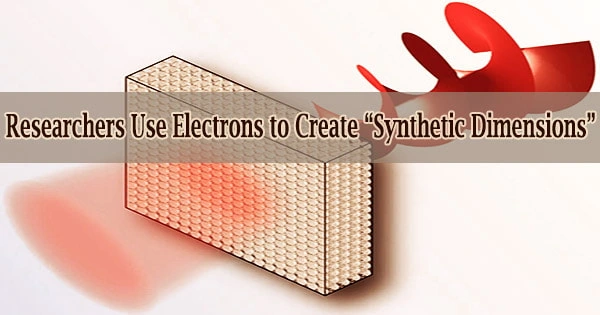Although we only have a three-dimensional spatial perception, scientists are still exploring what is possible in additional dimensions.
In new experiments, physicists at Rice University are pushing the limits of space. They have mastered the art of precisely controlling the electrons in enormous Rydberg atoms so that they may produce “synthetic dimensions,” which are crucial tools for quantum simulations.
The Rice team came up with a method to couple several Rydberg states of ultracold strontium atoms together using resonant microwave electric fields. When an atom’s one electron is energetically boosted to a highly excited state, supersizing its orbit and making the atom thousands of times larger than usual, this is known as a Rydberg state.
A millionth of a degree above absolute zero, Rydberg atoms are ultracold. Researchers from the Rice Quantum Initiative connected lattice-like Rydberg levels in ways that mimic real materials by accurately and adaptably controlling the electron velocity.
The methods might also make it possible to realize systems that are not possible in actual three-dimensional space, providing a potent new base for quantum study. In a study published in Nature Communications, the research was described by Rice physicists Tom Killian, Barry Dunning, and Kaden Hazzard, all of whom were involved in the endeavor. Lead author and graduate student Soumya Kanungo also contributed to the paper.
The 2018 exploration of Rydberg atoms by Killian and Dunning served as the foundation for this study. The highly excited electron can move between the several regularly spaced quantum energy levels that Rydberg atoms have by coupling them with microwaves.
A particle moving between lattice sites in a real crystal is mathematically equal to dynamics in this “synthetic dimension.”
“In a typical high school physics experiment, one can see light emission lines from atoms that correspond to transitions from one energy level to another,” said Hazzard, an associate professor of physics and astronomy who established the theoretical basis for the study in several previous papers. “One can even see this with a very primitive spectrometer: a prism!”
It is much easier to have control over coupling amplitudes when using millimeter waves to couple Rydberg atomic states. When we achieve that 1D lattice, with all the couplings in place, we can try to see what dynamics would result from exciting a Rydberg electron into that synthetic space.
Soumya Kanungo
“What is new here is that we think of each level as a location in space,” he said. “By sending in different wavelengths of light, we can couple levels. We can make the levels look like particles that just move around between locations in space.”
“That’s hard to do with light or nanometer-wavelength electromagnetic radiation but we’re working with millimeter wavelengths, which makes it technically much easier to generate couplings,” Hazzard said.
“We can set up the interactions, the way particles move and capture all the important physics of a much more complicated system,” said Killian, a Rice professor of physics and astronomy and dean of the Wiess School of Natural Sciences.
“The really exciting thing will be when we bring multiple Rydberg atoms together to create interacting particles in this synthetic space,” he said. “With this, we’ll be able to do physics that we can’t simulate on a classic computer because it gets complicated very quickly.”
By creating a Su-Schrieffer-Heeger system, a 1D lattice, the researchers showed off their methods. To make it, they applied microwaves with alternating weak and strong couplings to the appropriate synthetic landscape and utilized lasers to cool strontium atoms.
Atoms were excited to the manifold of linked, high-lying Rydberg states using a second set of lasers. According to Killian, the experiment showed how particles flow through the 1D lattice or, in some situations, how they remain stopped at the boundaries while having sufficient energy to move. This has to do with topologically based descriptions of material qualities.
“It is much easier to have control over coupling amplitudes when using millimeter waves to couple Rydberg atomic states,” Kanungo said. “When we achieve that 1D lattice, with all the couplings in place, we can try to see what dynamics would result from exciting a Rydberg electron into that synthetic space.”
“Using a quantum simulator is kind of like using a wind tunnel to isolate the small but important effects that you care about among the more complicated aerodynamics of a car or airplane,” Killian said.
“This becomes important when the system is governed by quantum mechanics, where as soon as you get more than a couple of particles and a few degrees of freedom, it becomes complicated to describe what’s going on.”
“Quantum simulators are one of the low-hanging fruits that people think will be early, useful tools to come out of investments in quantum information science,” he said, noting that this experiment combined techniques that are now fairly standard in labs that study atomic physics.
“All the technologies are well-established,” he said. “You could even conceive of this becoming almost a black box experiment that people could use, because the individual pieces are very robust.”
Postdoctoral researcher Joseph Whalen, graduate students Yi Lu and Sohail Dasgupta from Rice, as well as graduate student Ming Yuan from Rice and the University of Chicago, are co-authors of the study. Sam and Helen Worden Professor of Physics and Astronomy Dunning holds this position.
The Air Force Office of Scientific Research (FA9550-17-1-0366), the National Science Foundation (1904294, 1848304) and the Robert A. Welch Foundation (C-0734, C-1844, C-1872) supported the research.





